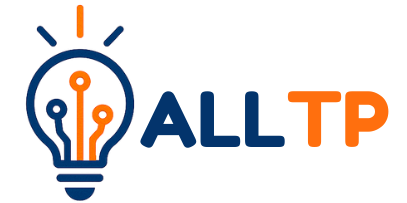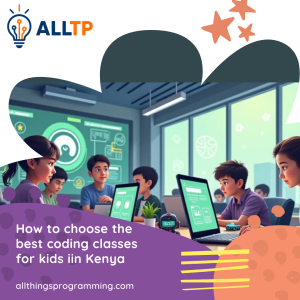The Competency-Based Curriculum (CBC) is Kenya’s modern education framework designed to equip learners with practical skills, values, and knowledge they can apply in real-life situations. Unlike the traditional exam-focused system, CBC emphasizes skills-based learning, encouraging creativity, critical thinking, problem-solving, and collaboration from an early age.
In today’s technology-driven world, coding Kenya programs have emerged as one of the most valuable digital skills. It not only teaches learners how to create software and digital tools but also sharpens logical thinking and innovation, qualities essential for thriving in the 21st-century job market.
All Things Programming plays a key role in supporting coding within the CBC framework by offering free, practical teacher training and ready-to-use, CBC-aligned lesson plans. This ensures schools can integrate coding without hiring new specialists or investing heavily in infrastructure, making it accessible even in resource-limited environments.
This raises a key question for educators and school leaders: Is coding currently part of the CBC curriculum, and what should school heads know to prepare for its integration?
Understanding CBC and Its Digital Literacy Component
Under the Competency-Based Curriculum (CBC), learning is organized into broad areas designed to develop well-rounded learners. Among these is the Science and Technology strand, which includes Digital Literacy, a key pillar for preparing students to navigate an increasingly digital world. Digital Literacy covers foundational computer skills, safe internet use, and exposure to technological tools that support creativity and problem-solving.
Coding fits naturally within these goals. By learning to code, students gain the ability to break down complex challenges into manageable steps, experiment with solutions, and build their own digital creations. These skills foster logical reasoning, creativity, and innovation, all of which are core to CBC’s learner-centered approach.
Even though coding is not yet a standalone subject, its concepts can be integrated into existing CBC strands such as:
- ICT lessons, where learners explore basic programming tools and interactive software.
- Science and Technology projects, which can include building simple games, animations, or data-driven activities.
- STEM clubs and extracurricular programs, where coding can be applied in robotics, digital design, and problem-solving challenges.
Is Coding Officially Part of CBC Right Now?
Coding is now formally recognized within the CBC framework, but not yet as a standalone, compulsory subject taught in every school. Rather, it is integrated as part of Kenya’s Digital Literacy Programme. This syllabus spans primary and lower secondary levels and can be delivered by any trained teacher, even those without a STEM or ICT background.
All Things Programming makes this possible by training the teachers to implement our AI, Coding and Robotics programs. You can read more about this initiative using this link in the standard.
Kenya has begun rolling out pilot projects to support this integration, most notably, an eight-month initiative in Lodwar where Grades 4–8 learners are introduced to creative coding and robotics using Scratch, supported by the Raspberry Pi Foundation and local partners. Teachers received training and equipment to facilitate this.
Summary for School Heads:
- Coding is officially part of the CBC, but delivered through Digital Literacy and not yet a universal or compulsory subject.
- Implementation is expanding through approved syllabi, pilot programs, and national digital strategies.
- Global momentum reinforces the value of coding as part of Kenya’s education transformation.
Why Coding Matters for Schools Under CBC
1. Skills Coding Builds
Coding is more than learning to write computer commands, it’s about developing a mindset for solving problems. Through coding activities, learners build:
- Critical thinking – analysing challenges and evaluating possible solutions.
- Logical reasoning – breaking down complex problems into clear, step-by-step processes.
- Problem-solving – applying trial-and-error, debugging, and refinement to reach the best outcome.
- Creativity – designing unique programs, games, or digital solutions that address real-world needs.
2. The Future Job Market
As the world becomes increasingly technology-driven, coding is becoming a foundational skill across multiple industries, not just in software development. From agriculture using automated systems to healthcare employing AI-powered diagnostics, coding literacy will be essential for many careers. Equipping learners early gives them a head start in pursuing opportunities in STEM fields, entrepreneurship, and digital innovation.
3. How Coding Supports CBC Goals
CBC is built on competency-based learning, where students demonstrate skills in real-world applications. Coding naturally supports this by:
- Encouraging hands-on projects that integrate multiple learning areas.
- Allowing learners to create tangible outputs, like apps, animations, or robotics programs.
- Promoting collaboration, as many coding projects involve teamwork.
- Helping students connect technology to problem-solving in their communities, reinforcing CBC’s emphasis on practical, transferable skills.
Challenges Schools Face in Integrating Coding
1. Budget Constraints for ICT Infrastructure
Many schools, especially public and community institutions, operate on tight budgets. Purchasing computers, tablets, or robotics kits and keeping them updated, can be expensive. Funding often prioritizes essential resources like textbooks, classrooms, and staff salaries, leaving little room for ICT investment.
2. Limited Access to Trained ICT Teachers
While CBC encourages digital literacy, many teachers have not received formal training in coding. This limits the ability to deliver engaging, accurate lessons. In some cases, ICT lessons are handled by teachers from other subjects who may lack confidence in coding skills.
3. Uneven Internet Connectivity
Rural and underserved areas often struggle with slow, unreliable, or nonexistent internet access. This hinders the use of online coding platforms, cloud-based tools, and virtual training for teachers, widening the gap between urban and rural schools in adopting coding.
4. Competition with Other Pressing Resource Needs
School heads must balance competing priorities: infrastructure upgrades, curriculum materials, staff development, and extracurricular programs. Introducing coding can be seen as an extra expense unless its long-term benefits are clearly demonstrated and aligned with CBC goals.
How All Things Programming Supports CBC-Aligned Coding Education
All Things Programming is a practical, cost-effective solution designed to help Kenyan schools integrate coding into the Competency-Based Curriculum without straining resources. The program focuses on empowering existing educators and leveraging available infrastructure to make coding accessible to all learners.
One of its key strengths is free, tailored teacher training. Instead of requiring schools to hire expensive ICT specialists, All Things Programming equips current teachers, regardless of their subject area, with the skills and confidence to deliver coding lessons effectively. This approach ensures coding can be embedded seamlessly into everyday CBC teaching.
Additionally, the program provides ready-to-use coding lesson plans and activities that are fully aligned with CBC competencies. These resources are designed to be adaptable for various grade levels, ensuring learners build practical digital skills while meeting CBC’s emphasis on problem-solving, creativity, and innovation.
Affordable Pathways to Introduce Coding in Your School
1. Start Small with Extracurricular Activities
Schools can begin by introducing coding clubs, hosting STEM challenges, or integrating simple programming tasks into existing ICT lessons. This low-pressure approach allows learners to explore coding in a fun, creative environment while building foundational skills.
2. Leverage Low-Cost Devices and Free Tools
Coding doesn’t always require expensive equipment. Schools can repurpose older computers, use affordable tablets, or even run coding lessons on shared devices. Free online platforms like Scratch, Code.org, and MIT App Inventor offer interactive coding experiences suitable for different age groups without costly software licenses.
3. Partner with Community Initiatives and Tech Programs
Collaboration with local tech hubs, NGOs, and education-focused organizations can open doors to training, mentorship, and resource-sharing. Programs like All Things Programming, community STEM centers, or volunteer-led workshops can help schools introduce coding without heavy financial investment.
All Things Programming as a Partner in Sustainable CBC Integration
Several Kenyan schools have already benefited from All Things Programming’s approach to teacher training and coding integration. For example, in participating primary schools, non-ICT teachers have been trained to deliver engaging coding lessons using low-cost devices and offline-friendly platforms. This has allowed learners to start building real coding skills without the school investing in expensive new labs.
The program tackles two of the biggest challenges in CBC coding adoption: infrastructure limitations and teacher skill gaps. By focusing on flexible teaching methods, offline-compatible coding tools, and practical lesson plans, schools can implement coding even with limited internet access or older equipment. Teachers gain the confidence to run coding activities as part of existing CBC lessons, making it a sustainable and scalable solution.
Looking ahead, All Things Programming’s vision is to scale coding education nationwide in alignment with CBC reforms. The goal is to ensure every learner, regardless of their school’s location or resources, has the opportunity to develop digital skills that will prepare them for the future workforce and position Kenya as a leader in technology-driven education.
What School Heads Should Do Next
1. Audit Current ICT Resources and Teacher Capacity
Begin by assessing the availability and condition of your school’s ICT equipment, internet connectivity, and teacher skills. Identify which staff members have basic computer knowledge and could be trained in coding instruction.
2. Plan for a Phased Introduction of Coding
Rather than overhauling your curriculum all at once, start small and expand gradually. Introduce coding into ICT lessons, pilot after-school clubs, or run short coding projects in STEM-related subjects. This phased approach makes integration manageable and budget-friendly.
3. Connect with Supportive Organizations
Partner with education-focused groups such as All Things Programming to access free teacher training, ready-to-use CBC-aligned coding materials, and guidance on implementing coding sustainably. Collaborating with such organizations ensures your school builds both teacher capability and student digital skills without overstretching resources.
Conclusion
While coding for beginners is not yet a standalone compulsory subject under the CBC, it is steadily becoming an integral part of Kenya’s education landscape through Digital Literacy and STEM-related activities. Forward-thinking school heads have an opportunity to act now, equipping learners with problem-solving, creativity, and digital skills that will prepare them for the future workforce.
By taking practical steps such as auditing resources, planning phased implementation, and partnering with initiatives like All Things Programming, schools can integrate coding in a way that is both cost-effective and sustainable. In doing so, they not only align with CBC’s vision of competency-based learning but also position their students to thrive in an increasingly technology-driven world.




